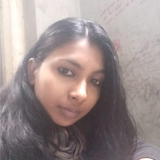Panchakanya of India's first all-female artists’ group – GetBengal story
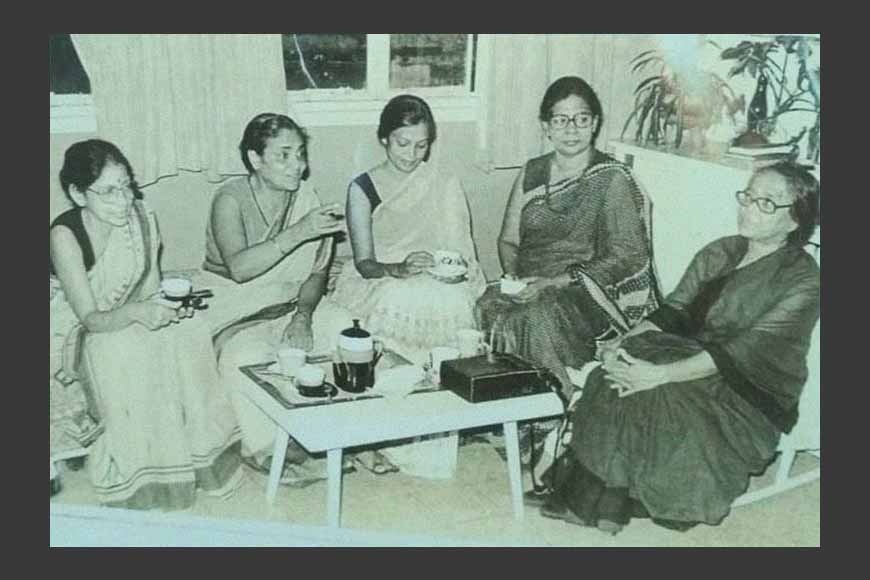
Meera Mukherjee, Karuna Saha, Shyamsree Basu, Shanu Lahiri, and Santosh Rohatgi (from the right)
In Bengal, the 1950s witnessed protest movements within the academic milieu, most importantly amongst university students. In the last decade, student bodies and unions began to assume a strong voice in academic institutions, with significant extended contributions and active participation in mainstream politics. This was a significant development because these impressionable, socially aware youth embodied the principles that would shape the next several decades.
Among the young artists of the post-60s, a significant segment were art school graduates, mostly in their 20s. While these rising aspirants shared a strong disapproval of the existing state of the visual arts, they were neither entirely clear nor immediately certain about a valid alternative in visual expression to be able to formulate a mature linguistic structure.
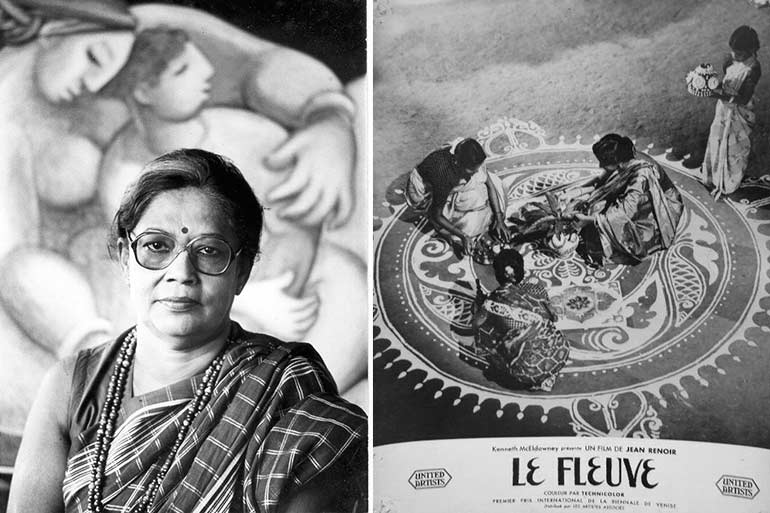 Karuna Saha and her Alpana on the poster for Jean Renoir's film 'The River'
Karuna Saha and her Alpana on the poster for Jean Renoir's film 'The River'
Several artist groups have emerged during this time: Progressive Artists Group, Calcutta Group, Society of Contemporary Artists, Calcutta Painters, Painters Orchestra, and Calcutta Sculptures, to name a few. Formed by contemporary art school students, their aim was to work on and develop indigenous genres, emphasising their individual styles. The post-1960s generation had grown up witnessing war, famine, genocide, partition, violent protests against economic disparity, joblessness, shortages of food, etc. Therefore, their art became the medium for reflecting the prevalent socio-political situation. The artists were no longer willing to confine their art to an aesthetic representation of the world around them.
However, the presence of female artists in these groups was nominal, or rather "non-existent." This was a reflection of the social order of the time. The opportunity to study or practice fine arts was not available to ordinary middle-class girls. Among those privileged few who did get that chance to study fine arts in established institutions like the Government College of Art and Craft (GCAC) at that time, many proved their mettle and talent at the international level. Five talented young female artists, namely Karuna Saha, Shanu Lahiri, Santosh Rohatgi, Meera Mukhopadhyay, and Shyamsree Basu, formed India's first artists’ association exclusively for women and formally named it ‘The Group’. Officially christened Pancha-kanya (Five Ladies) by the local media, these female artists were talented, brave, rebellious, and defiant.
Karuna Saha used to invite professional models to her home to pursue 'nude' figure studies. This created quite a stir in society, and conservative Hindus of the time were up in arms against her for defying existing social norms. However, when Paris returned, Saha disregarded all criticism and continued her work. Before 1939, a woman could not study art. In 1939, the prestigious Indian School of Oriental Arts opened its gates for female students, and Karuna was one of the first students to cross the precinct and enter the hallowed institution. While pursuing her degree, she joined the Swadeshi Movement in 1942, worked in refugee camps at Howrah, and was involved in various social works. She was arrested with other freedom fighters and served jail time for more than a year. In 1947, she got bail on the condition that she would not leave her home. After Independence, she was expelled from her college by the then-Principal, Mukul De, but was later re-admitted to complete her graduation.
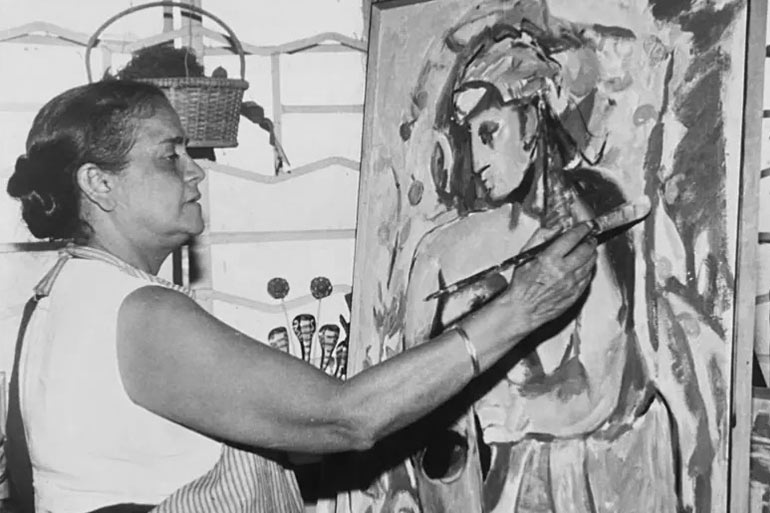 Artist Shanu Lahiri
Artist Shanu Lahiri
Saha participated in an all-India Postage and Stamp Delhi competition in 1949, and her design was selected as the best. She designed the first postal stamp for an independent India. When renowned filmmaker Jean Renoir visited Calcutta to shoot his film, ‘The River’, he met Karuna and requested that she paint a 9-foot-long Alpona for the film. She is seen drawing the alpona in the film. In 1946, Karuna was married to famous photographer Shambhu Saha, who did the cover for Jibanananda Das’s famous collection of poems titled ‘Bonolata Sen’ in 1942. The second edition's cover was done a decade later by Satyajit Ray in 1952.
It is most unfortunate that a gifted artist like Shanu Lahiri did not receive as much fame as she deserved. Her art was a mix of the soft and definitive—very seemingly commonplace—with surprise base notes. Shanu was the youngest of seven siblings and the youngest of three sisters in the Majumdar family. It was a family of diverse talents and a household of unusual abundance. By the time she was growing up, her two elder brothers, author Kamal Majumdar and artist Nirode Majumdar, were already established and respected figures in the city’s intellectual and artistic worlds.
In 1947, Shanu Majumdar entered the hallowed portals of the Government College of Art and Crafts, Calcutta, as one of the earliest batch of female students in that institution. After completing her graduation in 1951, Shanu went to study at the École du Louvre in Paris on a French government scholarship in 1956. She learned art history and appreciation and honed her skills as a painter at the Académie Julian. During her stay in Paris, she observed maestros like Picasso, Chagall and Rousseau at work from very close quarters. Like so many of her generation, Paris was to her the Mecca of modernism, and it was this legacy of the French ‘high modern’ that left the most lasting impact on her own innovations with form, colour, and composition.
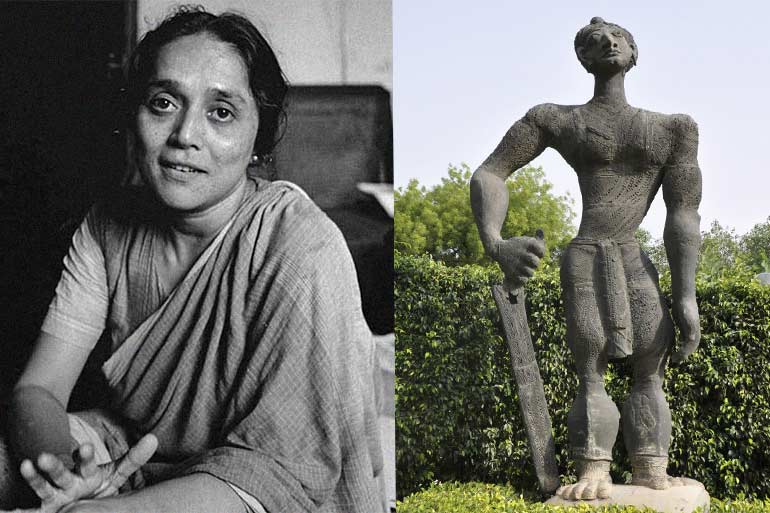 Meera Mukherjee and her bronze sculpture Ashoka at Kalinga in the courtyard of the Maurya Sheraton Hotel in New Delhi
Meera Mukherjee and her bronze sculpture Ashoka at Kalinga in the courtyard of the Maurya Sheraton Hotel in New Delhi
Large canvases, bristling with life, line, colour, brushwork, and splattered faces and torsos, carried the unmistakable stamp of a Shanu Lahiri style. By the latter half of the 1980’s, there was a perceptible shift in her work. A new simplification and economy of form, matched by restraint and reticence, dominated her work. She joined the Department of Painting at Rabindra Bharati University. Later, she would become Professor, Head of the Department, and Dean of the Visual Arts Faculty in 1985. It was during her stint as an educationist at Rabindra Bharati University that Lahiri’s Lansdowne Court home became the nerve centre of creativity. This was the place where the five female artists, including Lahiri, formed the country’s first and perhaps the only women’s artist group.
Artist Meera Mukhopadhyay was born in 1923, and she got her initial training in art at the Indian Society of Oriental Art. In 1947, she enrolled at the Delhi Polytechnic and earned a diploma in painting, graphics, and sculpture. In 1950, the famous Indonesian artist Affandi came to Kolkata as a state guest in Santiniketan, and Mukhopadhyay worked under him. She went to Germany in 1953 on a scholarship to study painting at the Hochschule für Bildende Kunst, Munich, but changed her stream and shifted to sculpture, the discipline that got her international fame. She studied under Toni Stadler and Heinrich Kirchner to learn bronze casting techniques from Kirchner and lithography from La Vasa Man. After her return from Germany in 1957, she worked as an art teacher in different schools, and then in 1960, she left teaching and took up sculpting full time. She worked as an apprentice with the traditional Dokra sculptors of Bastar, Chhattisgarh. Her sculptures crystallise a moment in time, depicting the common man doing daily chores. She was the recipient of various prestigious awards during her lifetime, including the Abanindranath Award and the Padma Shri. Mukhopadhyay’s sculptures are installed all over the country.
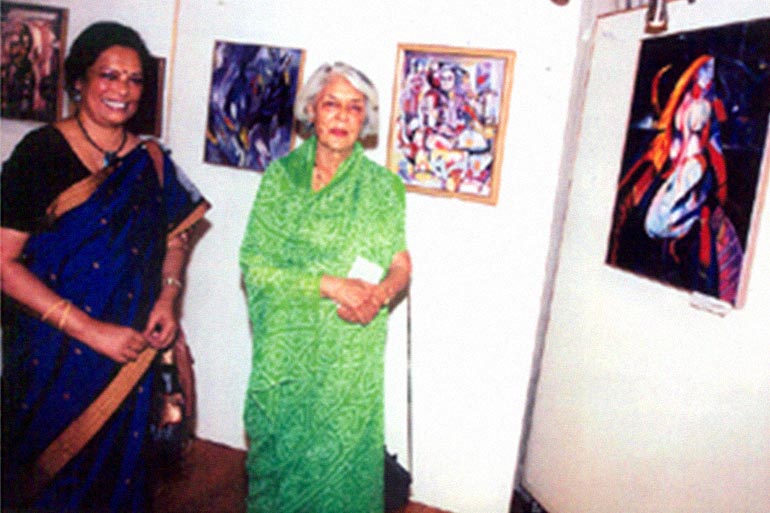 Maharani Gayatri Devi at Shyamsree Basu's exhibition in London
Maharani Gayatri Devi at Shyamsree Basu's exhibition in London
An alumnus of the esteemed Government College of Art and Crafts, artist Shyamsree Basu belonged to the most talented batch, which included Sunil Das, Jogen Chowdhury, and Anita Roy Chowdhury. She has received many awards and accolades for her paintings. Artist Santosh Rohatgi was also an alumnus of the Government College of Art and Crafts. She studied both Indian painting and, in her second year, took up Western painting. In 1968, Basu was one of two Indian women (the other being artist Nipa Moitra) whose work was displayed at the ‘International Portrait Exhibition’ in Sydney. Her classmates included Karthik Paine, Gopal Halder, Ganesh Halui, and Satyendra Poddar. In 1960, Basu received the French Fellowship to study at the Ecole de Beaux-Arts under Chaplain Midy. At different stages of her career, she evolved, and her style changed. She travelled extensively to different parts of the world and experimented with her work. She was influenced by Impressionism, Surrealism, and Dadaism. Afterwards, a hint of tribal art also crept into her works.
These ‘Pancha Kanyas’ travelled extensively and noticed the disparity between male and female artists. The five artists, however, were resolute and unequivocal about the necessity of an exclusive forum for women artists.
Since its inception in 1983, the group has exhibited annually at the Academy of Fine Arts. Its inaugural show was attended by illustrious personalities from different spheres of art and culture, including dancer Rani Karna, author Mahasweta Devi, journalist Aruni Mukherjee, Professor of History Ratnavali Chatterjee, and renowned sculptor Uma Siddhant. History was created. Later, many other upcoming and established female artists and sculptors joined the group. In 1986 and 1987, the exhibitions travelled for the first time outside Calcutta, to Triveni Kala Sangam in New Delhi and the Jehangir Art Gallery in Bombay. All five founding members of The Group have died, but the organisation continues to flourish. The baton of the association has been passed on to the next generation.
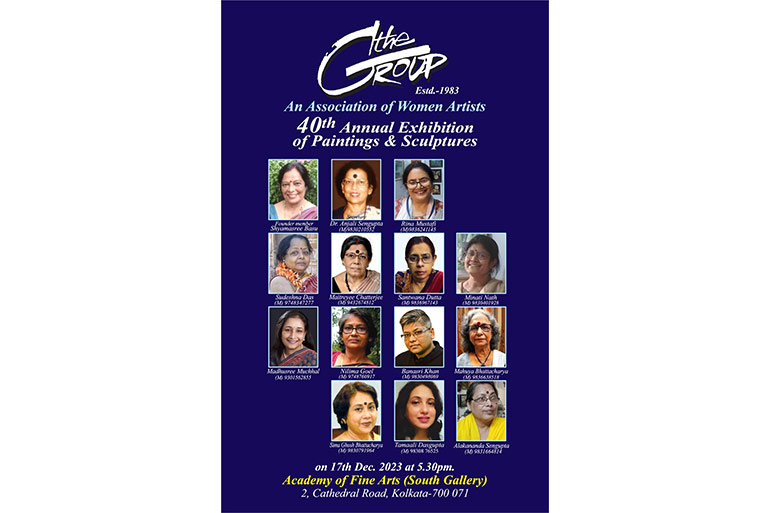 Poster for The Group's annual exhibition in 2023
Poster for The Group's annual exhibition in 2023
“None of the five daughters are there today. Shyamsree Bose, the last surviving member of the party, passed away last year. However, our current president and the senior-most member of the organisation, Anjali Sengupta, remains a guiding spirit. She has been associated with the group almost since its inception. Altogether, there are 13 active members at present. Many female artists participate with us in different ways. Apart from the annual exhibition, we organise special panel discussions on International Women's Day. Workshops are organised at different times of the year; we did a mural for an NGO during the COVID-19 pandemic. We try to give room to those women, who, despite being immensely talented artists, are not taken seriously in the artistic circles. There are many who cannot afford to exhibit, and we help them," says artist Tamali Dasgupta, an active member of "The Group".
Since five women artists formed this group, is there still a tendency to marginalise women artists within artist groups? Tamali Dasgupta says, “It has become a tradition of sorts." Look at the major artist groups, and it will become clear to you. There is a prevailing idea that women cannot give full attention to art since they have to multitask and cannot be full-time active artists. It is true that women have to take care of the family, but it is a misconception that one cannot paint while taking care of the family. Regardless of gender, patriarchy has deep roots. There would have been no need for girls to form a separate team if they had gotten the place they deserved.”






